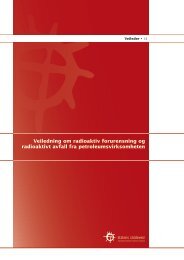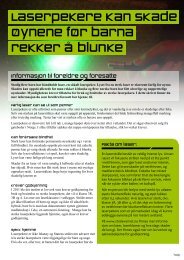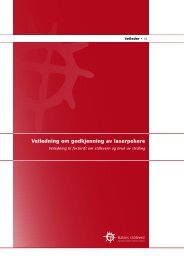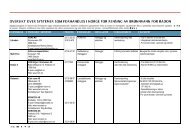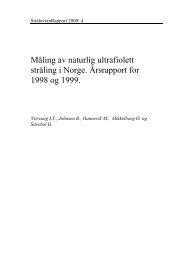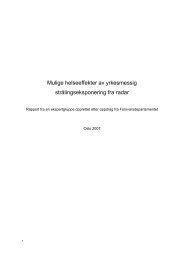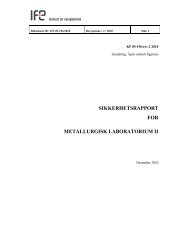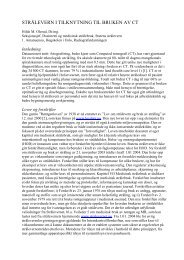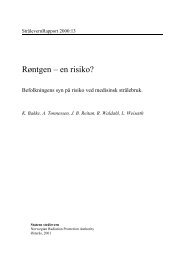Indoor Tanning in Norway - Statens strålevern
Indoor Tanning in Norway - Statens strålevern
Indoor Tanning in Norway - Statens strålevern
Create successful ePaper yourself
Turn your PDF publications into a flip-book with our unique Google optimized e-Paper software.
not for the facial position (Table A1) or for<br />
devices with fluorescent lamps <strong>in</strong> both body<br />
and facial positions (data not shown). Note that<br />
CIE-weighted irradiance, W/m 2<br />
0.35<br />
0.30<br />
0.25<br />
0.20<br />
0.15<br />
0.10<br />
0.05<br />
0.00<br />
UV total<br />
Long wave<br />
Short wave<br />
there were only six facial units measured <strong>in</strong><br />
1983-1992.<br />
1980 1985 1990 1995<br />
Year of approval<br />
2000 2005 2010<br />
Sun Oslo<br />
UV total<br />
Sun Oslo<br />
Short wave<br />
Sun Oslo<br />
Long wave<br />
Figure 2. Mean CIE-weighted short wave, long wave and total UV irradiances for tann<strong>in</strong>g models<br />
approved for cosmetic use <strong>in</strong> <strong>Norway</strong> <strong>in</strong> 1983-2005. The horizontal l<strong>in</strong>es show the irradiance limits<br />
and the vertical l<strong>in</strong>e when the new limits were <strong>in</strong>troduced. Yearly number of approved models is given<br />
<strong>in</strong> Appendix A. Correspond<strong>in</strong>g irradiance levels for summer sun <strong>in</strong> Oslo is <strong>in</strong>dicated to the right. This<br />
figure is modified from the publication <strong>in</strong> Photochemistry and Photobiology (“Trends <strong>in</strong> UV<br />
Irradiance of <strong>Tann<strong>in</strong>g</strong> Devices <strong>in</strong> <strong>Norway</strong>: 1983–2005”, Lill Tove N. Nilsen et al., DOI: 10.1111 ⁄<br />
j.1751-1097.2008.00330.x, Published article onl<strong>in</strong>e: 9. April 2008).<br />
3.3 Discussion of approved models<br />
The majority of the tann<strong>in</strong>g models approved<br />
for cosmetic use <strong>in</strong> <strong>Norway</strong> <strong>in</strong> the 1980s had<br />
only body lamps and the short wave irradiance<br />
was low. This was <strong>in</strong> agreement with the<br />
general European op<strong>in</strong>ion, i.e. lower UVB to<br />
UVA ratio compared to that of natural sun was<br />
considered less hazardous, and such lamps<br />
dom<strong>in</strong>ated the European market <strong>in</strong> the mid<br />
1980s (40, 41). In 1993-2005, the majority of<br />
approved models had fluorescent body lamps<br />
comb<strong>in</strong>ed with either high-pressure or<br />
fluorescent lamps <strong>in</strong> the facial position.<br />
Particularly the short wave irradiances were<br />
higher, even though the limit became stricter <strong>in</strong><br />
late 1992. It might be that the regulation<br />
process has led to production of new and more<br />
UVB-rich sunlamps result<strong>in</strong>g <strong>in</strong> an <strong>in</strong>crease <strong>in</strong><br />
total UV.<br />
There is some uncerta<strong>in</strong>ty <strong>in</strong> convert<strong>in</strong>g the<br />
spectral data for the most UVA-rich lamps<br />
approved <strong>in</strong> 1983-1992 to CIE-weighted<br />
irradiances, s<strong>in</strong>ce these differ spectrally from<br />
the majority of the fluorescent lamps that the<br />
conversion factors were based on (10). The<br />
ACGIH- and CIE-weight<strong>in</strong>g functions are<br />
spectrally comparable for UVB (280-315 nm)<br />
and short wave (250-320 nm) wavelengths.<br />
The CIE action spectrum, however, has low<br />
weight<strong>in</strong>g of the longer UVA wavelengths.<br />
Lamps with high UVA irradiance could not be<br />
approved with the old spectral limit of 200<br />
W/m², but can be approved with the new<br />
limits, e.g. high-pressure lamps (Table A5).<br />
The output variation with<strong>in</strong> the same lamp type<br />
can be large. NRPA has found a 20 % variation<br />
for some lamp types (data not shown). One<br />
should therefore expect the same order of<br />
variation <strong>in</strong> irradiance for the tann<strong>in</strong>g models.<br />
13



